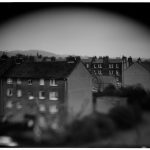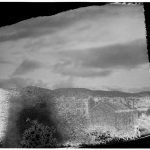Bob Crowley and I have been working on the New55 project for well over a year now. I forget even when it started. His blog has been visited heavily by eager fans of Polaroid Type 55, and criticised widely by some less-grateful citizens of the photographic community.
So how far have we got? Bob made the initial jump, by creating a first monobath reagent. He chose Kodak’s HC-110 as a developer base, as it has a long lifespan. He was using Ammonia and Ammonium Thiosulphate to boost pH and fix, but I got poor results from his mixture, and could not stand the smell, even with a respirator and ventilation (yes, my workshop is also the kitchen, so this mean the window and balcony door being open). So now that we knew it was possible to process a 4×5″ B&W neg in one pass, I moved on in my own direction. My first aim was to make the soup odourless, so I moved towards Sodium Thiosulphate and Sodium Hydroxide. My 8th mixture is what I started calling Reagent 4 beta 8, but now it is just R4. In under 5 minutes at 20c I was able to obtain negatives from Efke PL25, rated at 25ISO, that had a density and balance that is close to the delicacy that we like in T55. I was pleased.
The next step that Bob had been making over in Boston at the N55 “labs” at Soundwave Research were in assembling prototypes of pod-developed film to be field processed in a Polaroid 545 back. So I tried to figure out what the minimum amount of water needed to dissolve the solid chemicals in R4 was (not easy for a trial and error chemist like myself), and then added some Methylcellulose to the mixture to thicken it. I had made up about 2 35mm film canisters of reagent, and popped them in the film fridge. My first test was rather spartan, taping black paper and scraps together in a changing bag.
So what we have here is a control image developed in HC-110 dil-B as per normal, then a similar exposure (I was exposing 4 sheets at a time for tests) from my kitchen window in R4(b8), followed by a composite of my first p/n pod processed test (using fixed-out MGIV paper as a receiver), and finally the test that I did last night: the goop has been in the fridge for over a month, but my getting a heat sealer meant I could make pods, so I had to give it a shot, and it seems to work just fine. I taped things together in the changing bag, and using electrical tape as a light seal means that it has a tendency to buckle and thus break even contact between the surfaces. Oh well. But it proves the validity of my R4 even as a pod processed p/n. I can’t tell if the apparent contrast is to do with the concentrated chemicals, or just the fact that the chemicals were ‘mottled’ on the surface of the film, thus developing unevenly. The image was stable when I peeled it apart, but of course the anti-halation was still there, so i popped it in some fix to clear this, which is also less hassle than the Sodium Sulphate to clear T55 goop.
Now to order some Shanghai 4×5, get some receiver from Bob (via the 20×24 studio scraps corner), and some other bits, and I am curious to try and work with an all-raw chemicals mixture too.




